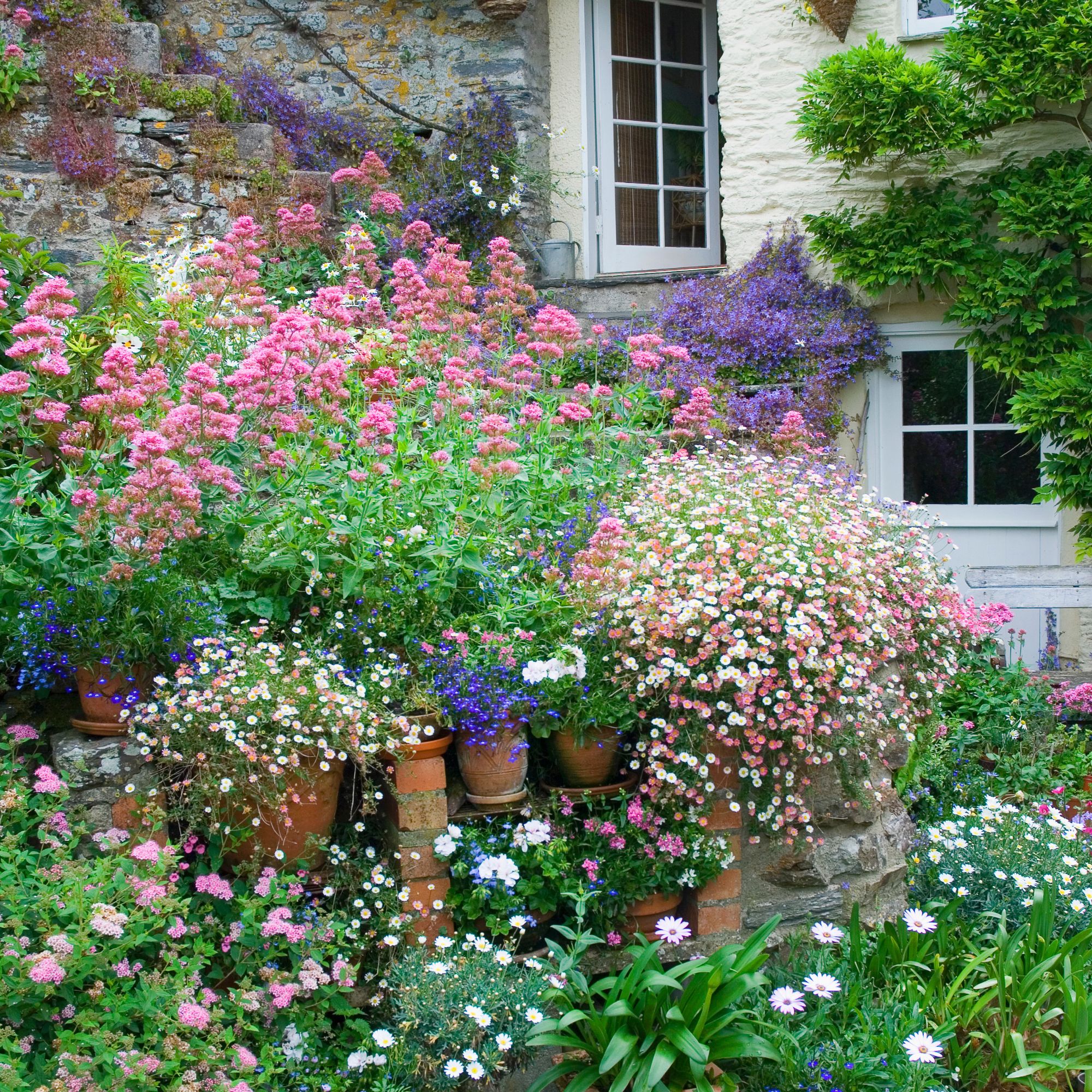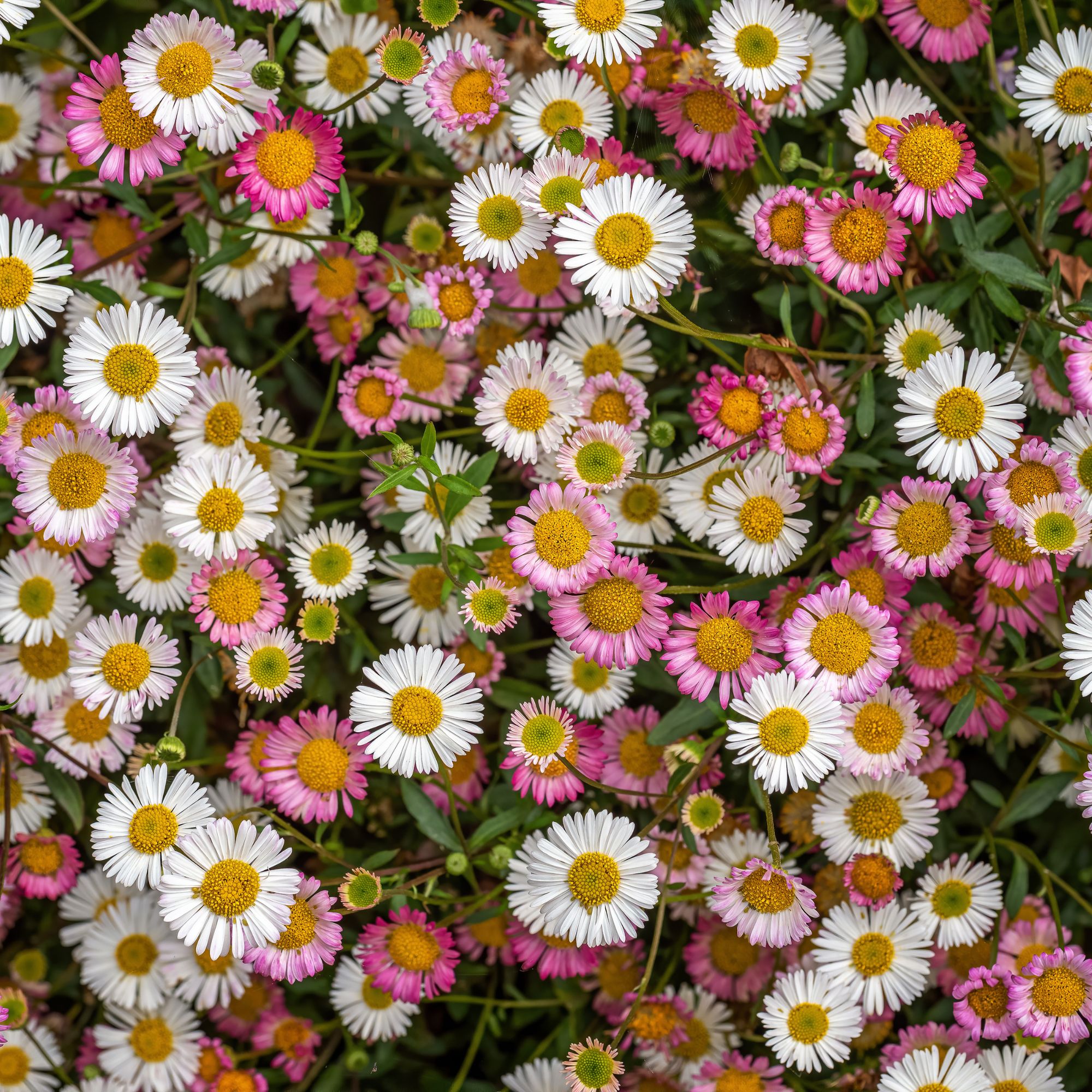
If you've been lucky enough to visit RHS Wisley this summer, you'll undoubtedly have spotted that there's one little flower in particular that's taken the spotlight: the not-so-humble Mexican fleabane.
One of our favourite long flowering perennials, the daisy-type blooms of Mexican fleabane (or Erigeron karvinskianus, to use its formal name) can be seen peeping out from all corners of Wisley at the moment – whether that be peeping between paving stones, adorning walled borders, or simply scattered in amongst the bigger, showier flowers.
Tempted to incorporate some into your flower bed or garden edging ideas? Here's what you need to know.
'Mexican Fleabane, or Erigeron karvinskianus, is truly a gem in any garden. I remember first seeing it at Wisley myself, and what struck me was how effortlessly it seemed to weave through the cracks in old stone walls and paths, almost like it had always belonged there,' says Steven Bell, the CEO of Paving Shopper,
Noting that its dainty white and pink flowers turn a lovely lavender as they age, giving any outdoor space a charming, cottage garden vibe, Steven explains that Wisley often uses plants that serve multiple purposes – both aesthetic and ecological – and that Mexican Fleabane is a perfect example of this.
'Its long blooming season, from late spring right through to the first frost, makes it invaluable for supporting pollinators,' he says. 'As I often say to clients, “If you want a garden that’s not just beautiful but also buzzing with life, this is the plant to go for,” because the bees and butterflies absolutely love it in a wildlife garden, too.'

Keen to grow some for yourself?
What you need
If you plan on growing your Mexican fleabane from seeds, you will need...
- Mexican fleabane seeds (try the Erigeron karvinskianus seeds from Crocus)
- Seed trays (we rate the Professional Seed Trays from Amazon)
- Seed compost (give Amazon's Westland John Innes Peat Free Seed Sowing Compost a go)
- Some small pots (like the Kinglake Plastic Small Plant Pots on Amazon)
Alternatively, you can try the potted Mexican fleabane plants on Thompson & Morgan for ease!
Step-by-step guide
Now that you have everything you need, it's time to get cracking...
1. Sow your seeds
If you're hoping to sow seeds successfully, the trick is to plant yours in trays of seed compost, keep them moist, and then pop their seedlings into individual pots when they're large enough to handle.
Give them time to acclimatise to the great outdoors by potting hardening them off in May (after the frosts have been and gone). Or, of course, you can skip the seedlings and go straight to plug plants...
2. Choose the right spot
Mexican fleabane is one of those plants that will happily grow in most conditions. As a rule, though, Craig says you ought to pick a sunny location with well-drained soil.
'If you have a rocky or sandy area that other plants struggle with, that’s where Mexican fleabane will thrive. I often tell people, “Think of the most inhospitable spot in your garden—this plant will probably love it,”' he says.
This writer's stepfather (who just so happens to be a qualified gardener) has even had luck pressing the rooted flowers into cracks in his brick wall, where they've taken root and flourished!
3. Water them well
After planting your Mexican fleabane, Steven says you'll need to water it well (ideally with harvested rainwater) to help it establish.

Once it’s settled in, though, you can pretty much leave Mexican fleabane to its own devices.
'Overwatering can be an issue, so it’s best to let the soil dry out between waterings,' he adds.
4. Let it spread naturally
Mexican fleabane will self-seed and spread with its roots, filling all the empty nooks and crannies in your garden with pretty blooms.
'If you want it to fill in gaps or cover an area, let it self-seed. You can also collect seeds and sow them in early spring, or divide established clumps to spread it around more quickly,' says Steven.
Award-winning garden designer Zoe Claymore, however, issues a word of caution when planting this little beauty, noting that it has the potential to spread a little too far sometimes.
'It's one of my favourite perennials,' she says, 'but it can take over a garden very quickly if you don't keep on top of it.'
5. And don't forget to deadhead
While Mexican fleabane requires very little maintenance, it is advisable to deadhead to encourage further flowering.
'Deadheading can encourage more blooms, but even if you don’t get around to it, the plant will continue to look lovely,' promises Steven. 'It’s pest-resistant and doesn’t suffer from many diseases, so it’s a great low-maintenance option.'
FAQs
Does Mexican fleabane come back every year?
This pretty perennial is a competent self-seeder, so it's one of those plants that will return to your garden year after year – which means you'll be treated to its daisy-like blooms from April through to November every year.
Should I cut back Mexican fleabane?
While Mexican fleabane tends to look after itself very well, the Royal Horticultural Society (RHS) advises you 'cut back at the end of the season if plants are looking straggly'.
As if you needed yet another reason to plant this perennial in your garden, Steven notes that 'Mexican Fleabane has a bit of a folk history' to it, too.
'Its name comes from its use in traditional Mexican medicine as a flea repellent. So, not only is it a beauty in the garden, but it’s also a plant with some interesting backstory, adding a bit of depth to why it’s such a beloved choice at places like Wisley.'
Easy to grow, low maintenance, a pretty perennial, and a plant with a story? You can fully expect to see Mexican fleabane all over our garden in the not-so-distant future, too...







